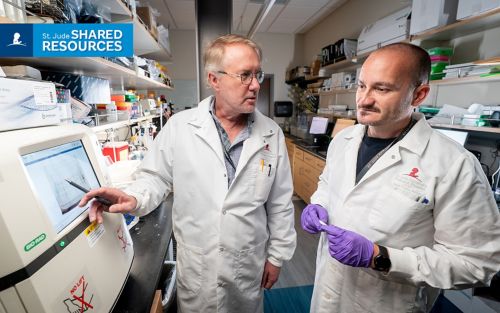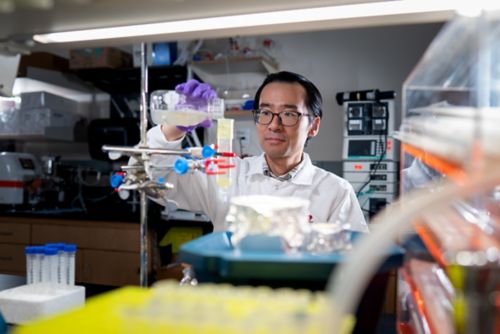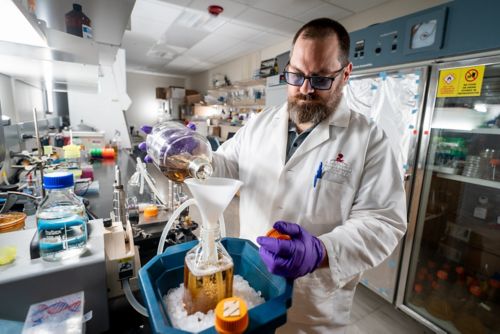St. Jude Family of Websites
Explore our cutting edge research, world-class patient care, career opportunities and more.
St. Jude Children's Research Hospital Home

- Fundraising
St. Jude Family of Websites
Explore our cutting edge research, world-class patient care, career opportunities and more.
St. Jude Children's Research Hospital Home

- Fundraising
Protein Production Facility accelerates research

Richard Heath, PhD, director of the Protein Production Facility, and Rosario Mosca, lead researcher, discuss their work.
Proteins are the worker bees of the body. They are molecules produced by the instructions encoded in DNA to perform specific functions. Essentially, they do the work. With such a fundamental role, it is unsurprising that proteins are often involved when disease strikes. Many scientists utilize proteins in their research; however, to study these proteins, you must acquire them from somewhere. The more specific the protein you are interested in researching, the harder it can be to obtain. That is where the St. Jude Protein Production Facility can help.
The Protein Production Facility streamlines the creation of custom proteins for research purposes, saving researchers money, speeding up their research and, ultimately, making a wider range of research studies possible.
“You can’t just go to a commercial company and click on a button that says, ‘I want this specific mutant protein,’” explains Richard Heath, PhD, Protein Production Facility director. “That’s where we come in.”
The Protein Production Facility provides high-quality and cost-effective proteins for biochemical assay and structure determination studies. It supports the translation of discoveries in molecular and cellular biology to chemical and structural biology.
“Our facility allows scientists who aren’t protein chemists to access high-quality proteins for their research,” Heath says. “We’ve worked with nearly every department at St. Jude, helping with various projects from cancer research to vaccine development.”
Heath and others at the Protein Production Facility have worked on over 2,400 different proteins for St. Jude researchers since the facility began operating 24 years ago. It started as a single biochemistry lab but quickly grew into a larger operation as more researchers throughout St. Jude wanted to take advantage of its services and expertise.
Making more discoveries possible
Health likes to tease that “genes are boring; it’s the proteins that do stuff.” However, there is some truth to this regarding increasing complexity from genes to proteins. Genetic studies can reveal much about what a cell plans to do (and when and where its best-laid plans might go awry). However, to confirm what actually happens once the DNA blueprints are translated into protein action in both well-functioning and poorly-functioning or diseased cells, researchers need to study the resultant proteins and their interactions.

Associate scientist Wei Wang, at work in the Protein Production Facility.
“That’s an important part of cancer research,” Heath says. “What protein does the functional gene create, what does it look like, and what does it do in our bodies? And then what happens when the gene mutates? If it still creates a protein, what does it look like, and what does it do? To answer these questions, we at the Protein Production Facility can produce the normal version and various mutant forms so that researchers can study each in isolation to understand the changes happening.”
Why can’t cancer researchers study these proteins in cancer cell culture or animal models, where diseased cells are already producing them? While the researchers may do this down the line, there are some answers they can only get by looking at the structure and interactions of purified proteins.
“You might think you have worked out a mechanism or interaction between two proteins in vivo, but then, when you study the purified and isolated proteins of interest, it doesn’t work,” Heath says. “Maybe a third protein was involved that you didn’t even know about. So, then we purify that third protein, so you can layer it into your study to elucidate a more complex multi-protein interaction.” Some questions can only be answered by first reducing the complexity and then layering it back in with downstream in vivo studies.
Of course, reducing scientific complexity is not as easy as it sounds. These elegant, purified protein studies require great skill and expertise in creating specific proteins from scratch and ensuring that each purified protein sample contains only a particular protein or even a specific version or isoform of that protein. You also need enough copies of the protein in the sample to conduct robust experiments. These samples can get pricey if purchased from a commercial source, costing thousands of dollars for a single milligram. Alternatively, the Protein Production Facility can offer these types of protein samples to St. Jude researchers at a fraction of the cost.
An in-house protein store
In addition to offering custom protein expression and purification, Heath’s team is now building up an in-house store of common proteins St. Jude researchers need for their research. “We want to make these frequently used proteins available so that researchers can visit our website and order a vial with the click of a button,” Heath says.
One example is Cas9, a protein that acts as a “molecular scissor” to cut DNA at a specific location. Cas9 is a key component of the increasingly popular and powerful CRISPR-Cas9 genome editing system. As more researchers at St. Jude have begun conducting genome editing experiments and studies — for example, to create cell models containing genetic variants associated with disease to study early disease mechanisms — demands for the Cas9 protein have skyrocketed. By creating this protein in-house at scale and offering it to St. Jude researchers who would otherwise need to order it from a commercial source, the Protein Production Facility saves the institution over $500,000 annually.

Terry Coop, a scientist in the Protein Production Facility helps propel research at St. Jude.
Elena Govorkova, MD, PhD, is the Lead Scientist-Directing in the laboratory of Richard Webby, PhD, in the St. Jude Department of Host-Microbe Interactions. She works with the Protein Production Facility to produce high-quality proteins for influenza research, including viral surface proteins used in vaccine and immune response studies and polymerase proteins used in antiviral studies.
Govorkova’s team can use these proteins to study whether antibodies generated in response to infection with one influenza type — antibodies that recognize a given surface protein — can also recognize the surface proteins on another type. They can take surface protein genes, introduce mutations, and then send these to the Protein Production Facility to be translated into proteins to study whether new mutant forms of surface proteins might evade antibody detection or vaccine immunity. They can also determine which influenza types an organism has been infected with by collecting samples to see which antibodies they have in their blood.
“These proteins can be useful in experimental settings and public health settings,” Govorkova says.
In collaboration with the Protein Production Facility, Govorkova and her colleagues published a study in 2020 looking at the functions of the polymerase influenza virus proteins with different substitutions. The research investigated how changes in an influenza virus polymerase complex protein, which helps to copy and carry out the instructions of the virus’s genetic material, can help the virus evade baloxavir, a new prescription antiviral drug for influenza.
The Protein Production Facility helped Govorkova’s team create modified virus proteins with specific amino acid changes, which the researchers then used to test whether baloxavir could still hinder the protein’s activity. The researchers determined which specific amino acid changes result in lowered antiviral drug effectiveness. This is critical knowledge given that influenza viruses regularly mutate and evolve. Knowing which changes might make the virus resistant to current antiviral drugs is key to treating infections and limiting spread.
“Our expertise in influenza research, combined with the Protein Production Facility’s specialized protein production capabilities, makes our unique work possible,” Govorkova summarizes.
How are proteins created for research?
If you visit the Protein Production Facility, you’ll see large equipment — incubators and fermenters — designed to grow miniature, living protein factories, especially bacteria. To create and purify specific proteins, researchers at the Protein Production Facility often use E. coli and some insect and mammalian cells as factories.
“Our job is to convince bacteria, insect cells or mammalian cells to make foreign proteins for us in large amounts,” Heath says. His team does this by inserting plasmids, circular DNA structures designed to carry genes of interest, into bacterial or other to-be-protein-factory cells. These plasmids instruct the cells to translate the genes they carry into proteins — like how a virus harnesses its host to create its products.
Once the factory cells have created large amounts of the target proteins, it is time for purification. Proteins are run through liquid chromatography systems that pull out specific proteins based on tags designed into them from the start. The process can get more complicated and require optimization to ensure the proteins are soluble and properly folded, but it typically produces high-quality proteins for research purposes. The Protein Production Facility has a 94% success rate for protein expression and purification and can create protein samples at 99% purity in high quantities.
“Working with the protein production team makes one forget how ‘slippery’ or ‘sticky’ or ‘stubborn’ some proteins can be,” says Aseem Ansari, St. Jude Department of Chemical Biology & Therapeutics chair, who has worked with proteins produced by the Protein Production Facility. “They can conjure up some of the most misbehaved proteins and do it at a scale that makes otherwise impossible studies possible.”
With the Protein Production Facility team handling the technical complexity of making proteins for research, St. Jude scientists can move faster toward making discoveries. Proteins themselves seem to share a purpose with the people who make them — each playing a fundamental role in helping them get things done.






